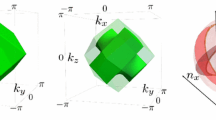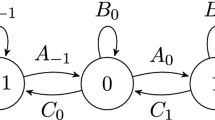Abstract
If a one-dimensional quantum lattice system is subject to one step of a reversible discrete-time dynamics, it is intuitive that as much “quantum information” as moves into any given block of cells from the left, has to exit that block to the right. For two types of such systems — namely quantum walks and cellular automata — we make this intuition precise by defining an index, a quantity that measures the “net flow of quantum information” through the system. The index supplies a complete characterization of two properties of the discrete dynamics. First, two systems S 1, S 2 can be “pieced together”, in the sense that there is a system S which acts like S 1 in one region and like S 2 in some other region, if and only if S 1 and S 2 have the same index. Second, the index labels connected components of such systems: equality of the index is necessary and sufficient for the existence of a continuous deformation of S 1 into S 2. In the case of quantum walks, the index is integer-valued, whereas for cellular automata, it takes values in the group of positive rationals. In both cases, the map \({S \mapsto {\rm ind} S}\) is a group homomorphism if composition of the discrete dynamics is taken as the group law of the quantum systems. Systems with trivial index are precisely those which can be realized by partitioned unitaries, and the prototypes of systems with non-trivial index are shifts.
Similar content being viewed by others
References
Ahlbrecht A., Vogts H., Werner A.H., Werner R.F.: Asymptotic evolution of quantum walks with random coin. J. Math. Phys. 52, 042201 (2011)
Arrighi, P., Nesme, V., Werner, R.F.: Unitarity plus causality implies locality. http://arxiv.org/abs/0711.3975v3 [quant-ph], 2009
Avron J., Seiler R., Simon B: The index of a pair of projections. J. Funct. Anal 120, 220–237 (1994)
Beckman D., Gottesman D., Nielsen M.A., Preskill J.: Causal and localizable quantum operations. Phys. Rev. A 64, 052309 (2001)
Bratteli, O., Robinson, D.W.: Operator algebras and quantum statistical mechanics. I+II. New York: Springer, 1979, 1997
Buchholz D.: The physical state space of quantum electrodynamics. Commun. Math. Phys 85, 49–71 (1982)
Gao X., Nguyen T., Strang G.: On factorization of m-channel paraunitary filterbanks. IEEE Trans. Signal Proc 49(7), 1433–1446 (2001)
Hedlund G.A.: Endomorphisms and automorphisms of the shift dynamical systems. Math. Syst. Th 3(4), 320–375 (1969)
Hein M., Eisert J., Briegel H.: Multi-party entanglement in graph states. Phys. Rev. A 69, 062311 (2004)
Kari J.: Representation of reversible cellular automata with block permutations. Math. Syst, Th 29(1), 47–61 (1996)
Kato T.: Perturbation theory of linear operators. Springer, Berlin-Heidelberg-Newyork (1995)
Kitaev A.: Anyons in an exactly solved model and beyond. Ann. Phys 321, 2–111 (2006)
Nielsen M.A., Chuang I.L.: Quantum computation and quantum information. Cambridge University Press, Cambridge (2000)
Roe, J.: Lectures on coarse geometry. Providence, RI: Amer. Math. Soc., 2003
Schlingemann D., Werner R.: Quantum error-correcting codes associated with graphs. Phys. Rev. A 65(1), 012308 (2001)
Schumacher, B., Werner, R.: Reversible quantum cellular automata. http://arxiv.org/abs/quant-ph/0405174v1, 2004
Vogts, H.: Quanten-Zellularautomaten mit lokalen Erhaltungsgrößen. Diplomarbeit, Braunschweig 2005, http://www.imaph.tu-bs.de/ftp/vogts/dip_hv.pdf
Werner R.F.: Local preparability of states and the split property in quantum field theory. Lett. Math. Phys 13(4), 325–329 (1987)
Zanardi P.: Stabilizing quantum information. Phys. Rev. A 63, 12301 (2001)
Author information
Authors and Affiliations
Corresponding author
Additional information
Communicated by M. B. Ruskai
Rights and permissions
About this article
Cite this article
Gross, D., Nesme, V., Vogts, H. et al. Index Theory of One Dimensional Quantum Walks and Cellular Automata. Commun. Math. Phys. 310, 419–454 (2012). https://doi.org/10.1007/s00220-012-1423-1
Received:
Accepted:
Published:
Issue Date:
DOI: https://doi.org/10.1007/s00220-012-1423-1




